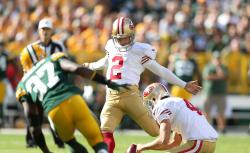Let’s narrow the discussion even further, to the discipline I care about most: placekicking. Brian, you note that NFL kickers are more accurate than ever, and you’re damn right they are. Small sample size, warm weather, etc., but in Week 1 kickers made 67 of 72 field-goal attempts, or 93 percent. Oh, and the 49ers’ David Akers became the fourth kicker—after Tom Dempsey in 1970, Jason Elam in 1998, and Sebastian Janikowski last year—to kick a 63-yarder. He also became the fifth active NFL kicker to make one from beyond 60.
I’ve written before that the improvement in NFL kicking since the 1970s is one of the greatest non-equipment-aided performance leaps in any sport. Today’s kickers are bigger, stronger, physically and mentally better conditioned, and, most important, more technically sophisticated than their counterparts in the early days of the “sidewinder” or “soccer-style” kicker. This guy, for one, wouldn’t sniff the field today.
Kickers are so good now—more precisely, the distance from which they can score three points and their accuracy from all distances has increased to such a degree—that NFL coaches use them more than ever. NFL teams attempted a record 1,011 field goals in 2011, which works out to about four attempts per game. In 1984, the figure was 3.5 FG/G. In 1974, it was 3.0. As kickers have improved, the NFL has tried to make their job harder: in 1974, moving the goalposts to the rear of the end zone; in 1995, placing the ball at the spot of the kick instead of the line of scrimmage after a missed FG; in 1999, making them boot new, hard K balls.
I love a field goal more than most, but I also understand that the mythical family of four isn’t forking over $444 to watch Greg Zuerlein and Steven Hauschka take three-step approaches. But I’d also argue that disincentivizing long kicks is a dumb idea. Here’s a hypothetical: With a couple of minutes to go in the second quarter of a tie game, it’s fourth-and-10 for the Titans from the Steelers’ 40-yard line. Tennessee can go for it, punt, or send Rob Bironas on to try a 58-yard field goal. Brian’s numbers say go for it, because retaining possession is so important. Punting the ball away makes the least mathematical sense, because the Steelers can make up the 30 or so net punting yards in a couple of plays, but it’s the perceived “safe” decision. Kicking a field goal is usually the third choice. Almost 60 yards is far, and failure will net the Steelers eight bonus yards of field position, giving them the ball at the 48 rather than the 40.
But is 58 yards really unlikely for a strapping fellow like Bironas? He’s an astonishing 21-for-29 from 50-plus in his career, including a 60-yarder. As a group, NFL kickers converted 64 percent of attempts from beyond 50 last season. Dudes like Bironas, Janikowski (who once convinced his coach—OK, it was Lane Kiffin—to let him try a 76-yarder), Matt Prater of Denver, and Mason Crosby of Green Bay are monsters of the midfield. Let them show off their legs!
How can we make that happen? A listener of Slate’s sports podcast Hang Up and Listen wrote in this week arguing that the NFL should revert to the old rule on ball placement after a missed field goal. That would bump up the long FG option in the coach’s decision-making calculus, and as a result they’d go for long boots more often. And that would be good for the game. Long kicks showcase power, which fans appreciate. They are about scoring, which, obviously, is central to the outcome of a game. They are filled with tension and wonder. And, as my correspondent, David Harris, a Giants fan from Roselle Park, N.J., observed, they allow kickers to display the full range of their talents.
“I’m not any more partial to kickers than I am to any other part of football,” Harris wrote, “but I’ve always enjoyed watching long field-goal attempts, somewhat to my embarrassment. Why is this feeling so odd, though? Can’t people watch golf for hours and get a positive feeling just from watching a ball go in a hole?”
Harris is right—who wouldn’t be up for seeing more 60-plus-yard blasts? Akers’ kick was fantastic: a line drive, straight as a hashmark, nice end-over-end rotation, a Packer leaping to try to goaltend it (which would have been illegal), an audible doink! off the crossbar, a friendly bounce into the record books, and a celebratory dogpile in the center of Lambeau Field.
“All 32 of us would like to get out there and get a look at it for sure if the conditions are right,” says San Diego kicker Nate Kaeding (who went five-for-five on Monday night in his return from ACL surgery). By “conditions,” Kaeding means more than wind and weather. Plus-size kicks occur only in virtually risk-free circumstances: at the end of the first half or the end of the game. “All the dots have to connect for a kicker to get the chance,” he told me.
Praising Akers’ physical and mental ability, Kaeding adds that “getting a look at it and capitalizing on it like David did are two different things.” But eliminating the eight-yard post-miss gift to the defense would alter decision-making for the offense, and increase the opportunity for more attempts from far away. And that would let kickers test themselves and give fans the pleasure of seeing how far a human can kick an NFL football. “There’s a handful of guys who could stretch that thing out to 70,” Kaeding says. “The record certainly has the potential to be knocked off.”
